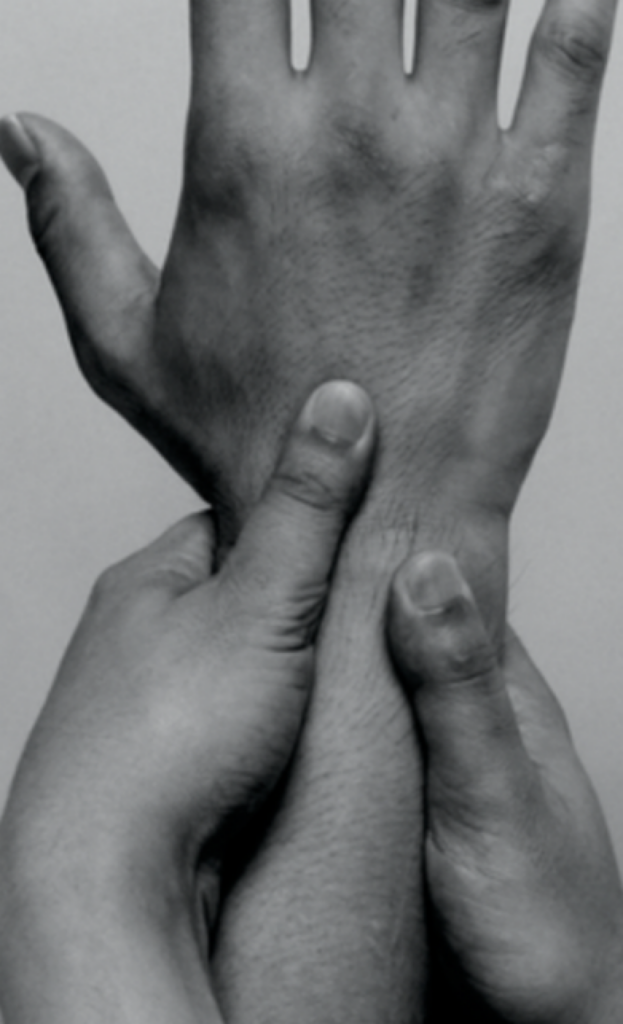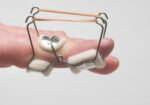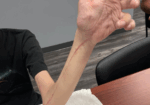Ballottment Test for Wrist DRUJ
Reliability and Validity Analysis of the Distal Radioulnar Joint Ballottement Test
Nagashima, M., Omokawa, S., Hasegawa, H., Nakanishi, Y., Kawamura, K., & Tanaka, Y. (2024). Reliability and validity analysis of the distal radioulnar joint ballottement test. The Journal of Hand Surgery, 49(1), 15–22. https://doi.org/10.1016/j.jhsa.2023.10.006
The Skinny: Distal radioulnar joint (DRUJ) wrist instability can be caused by triangular fibrocartilage complex (TFCC) injuries. This joint injury can be clinically determined with the ballottement provocative test. There are a handful of tests to determine DRUJ instability, but the ballottement test is an accurate manual test for DRUJ instability. This study looks at the validity of the ballottement test for TFCC injury using a 3-D electromagnetic tracking device. For this study, the examiner grasps the radius and the carpal bones while the other hand grasps the ulnar head and loads are applied in the volar and dorsal directions, which is different from the non-holding method in which the radius is grasped without grasping the carpal bones while the other hand grasps the ulnar head and loads are applied in the volar and dorsal directions.

Image from: Onishi, T., Omokawa, S., Iida, A., Nakanishi, Y., Kira, T., Moritomo, H., Ruxasagluwang, S., Kraisarin, J., Shimizu, T., & Tanaka, Y. (2016). Biomechanical study of distal Radioulnar Joint Ballottement Test. Journal of Orthopaedic Research, 35(5), 1123–1127. https://doi.org/10.1002/jor.23355
In the Weeds: This study had 25 healthy participants (10 men and 15 women) and 8 participants with TFCC injuries (6 men and 2 women). Three orthopedic hand surgeons were utilized in the study to perform the ballottement test. A 3-D electromagnetic tracking device was used to measure the rotation angle of the forearm during the test.
Bringing it Home: This study was able to demonstrate that the ballottment wrist test using the holding technique was able to detect TFCC foveal tears with 80% accuracy 82% sensitivity, and 77% specificity. Due to the high diagnostic accuracy, the ballottment test was identified as an effective way to determine mild or moderate DRUJ instability.
Rating: 4/5
This study had several limitations:
1) The sample size was small which isn’t the best representation
2) The study did not include those with DRUJ instability above grade 2
3) There were no comparisons for age and sex
4) The individual joint differences were not included
5) The load applied to the ballottment test was not measured
6) Joint laxity was not assessed
Despite the limitations, the study does prove that the ballottment test using the holding technique was able to detect TFCC foveal tears with 80% accuracy, allowing healthcare professionals to have an appropriate measure of TFCC foveal tears.
Photo: Onishi, T., Omokawa, S., Iida, A., Nakanishi, Y., Kira, T., Moritomo, H., Ruxasagluwang, S., Kraisarin, J., Shimizu, T., & Tanaka, Y. (2016). Biomechanical study of distal Radioulnar Joint Ballottement Test. Journal of Orthopaedic Research, 35(5), 1123–1127. https://doi.org/10.1002/jor.23355
1 Comments
Leave a Comment
More To Read
Soft Tissue Healing in Pediatrics
By: Chelsea Gonzalez Why do pediatric clients often not require as much hand therapy for soft tissue injuries when compared to adults? The simple answer: Kids have very elastic soft tissue, which can return to its original shape and position after stretch. This elasticity is lost with time as collagen fibers expand and their internal…
Read MoreDo you know the secret ingredient to recovering from an injury?
Do you know the secret ingredient to recovering from an injury? I will give you a hint it is 5 letters and begins with the letter S. SLEEP Have you ever asked yourself a question – does sleep help injuries heal? This is for you to share with your patients but also serve as a…
Read MoreManagement of the Stiff Finger: Evidence and Outcomes
Title: Management of the Stiff Finger: Evidence and Outcomes Reference: Yang, G., McGlinn, E. P., & Chung, K. C. (2014). Management of the stiff finger: Evidence and outcomes. Clinics in Plastic Surgery, 41(3), 501–512. https://doi.org/10.1016/j.cps.2014.03.011 Article Review By: Tommi Hintnaus The Skinny: This study focuses on understanding and managing finger stiffness, a condition characterized by…
Read MoreArteriovenous Malformation (AVM hand)
By: Amalia Garcia Introduction After completing three weeks of my Level II hand therapy rotation, I have seen a wide variety of common upper extremity injuries such as carpal tunnel syndrome, distal radius fractures, mallet finger, flexor tendon lacerations, arthritis, and more. One condition that stood out to me was one that I hadn’t heard…
Read MoreSign-up to Get Updates Straight to Your Inbox!
Sign up with us and we will send you regular blog posts on everything hand therapy, notices every time we upload new videos and tutorials, along with handout, protocols, and other useful information.







very to the point and helpful…. thanks
I alway go to you info for up to date evidence and practical and easy to follow demo.
Hand Therapist; NHS . UK